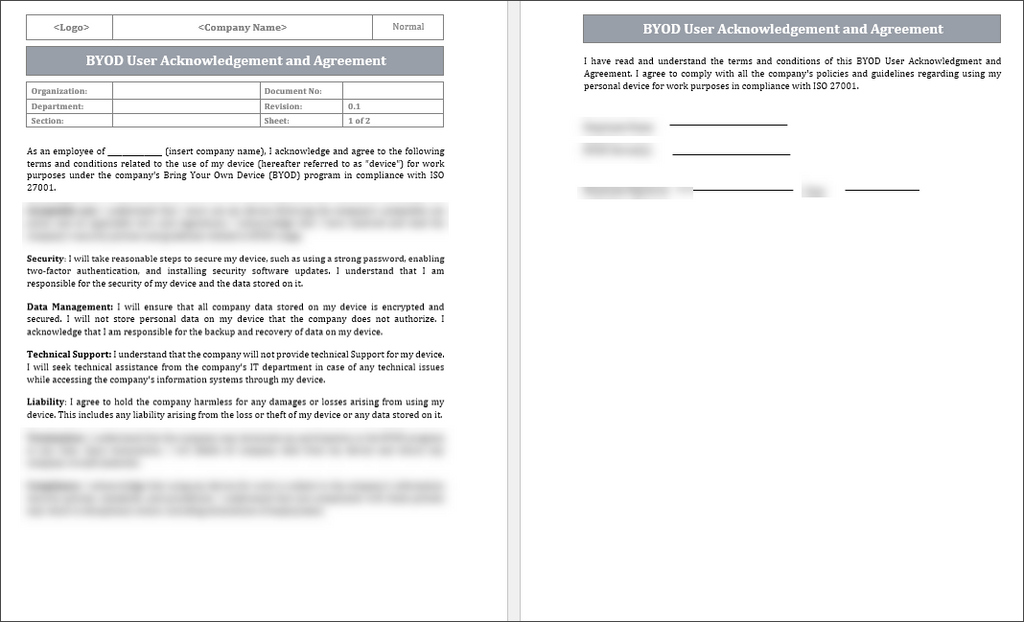
In ISO 27001, the BYOD (Bring Your Own Device) User Acknowledgement and Agreement is a crucial document used to formalize the understanding and responsibilities between employees (users) and the organization when they choose to use their devices for work-related activities.

BYOD is a practice where employees use their personal laptops, smartphones, tablets, or other devices to access the organization's network, systems, or applications to perform work-related tasks. While BYOD can enhance productivity and flexibility, it also introduces security risks and challenges for an organization's information security management.
The User Acknowledgement and Agreement plays a crucial role in ISO 27001, especially concerning implementing the Bring Your Own Device (BYOD) policy . Here are some key reasons why it is essential:
The User Acknowledgement and Agreement is instrumental in promoting a secure BYOD environment within the organization. It enables effective risk management, enhances security awareness, and ensures that both employees and the organization are aligned in their efforts to protect sensitive information from potential threats.

By incorporating these legal considerations and best practices into the ISO 27001 implementation process, organizations can demonstrate their commitment to information security, comply with legal requirements, and effectively protect their information assets from potential threats.
In ISO 27001, monitoring and updating the agreement related to information security practices, including the User Acknowledgement and Agreement for BYOD, is a critical part of maintaining an effective Information Security Management System (ISMS). As the organization's IT landscape, security risks, and legal requirements evolve, the agreement should be periodically reviewed and adjusted to ensure its relevance and effectiveness. Here are the key steps for monitoring and updating the agreement as needed:
1.Regular Review:
Schedule periodic reviews of the agreement to assess its effectiveness and continued relevance.
Consider conducting reviews at least annually or when significant changes occur in the organization's operations, IT infrastructure, or legal requirements.
2.Monitoring Compliance:
Continuously monitor user compliance with the agreement's terms and conditions.
Analyze incident reports, security logs, and user feedback to identify any recurring issues or potential areas for improvement.
3.Stay Current with Legal and Regulatory Changes:
Monitor changes in relevant data protection, privacy, and security laws and regulations.
Ensure that the agreement aligns with the latest legal requirements to maintain compliance.
4.Incident Analysis:
Conduct post-incident analyses to identify any weaknesses or gaps in the agreement.
Use incident data to determine if additional clauses or security measures need to be included in the agreement.
5.Employee Training and Awareness:
Include information security awareness training as part of the onboarding process for new employees.
Regularly update existing employees on any changes to the agreement and reinforce the importance of adhering to its requirements.
6. Feedback Mechanisms:
Establish feedback mechanisms for employees to provide input on the agreement.
Encourage employees to report any potential issues or concerns related to the agreement's terms and conditions.
7. Collaborate with Legal and HR Departments:
Work closely with the legal and HR departments to ensure that the agreement aligns with company policies and practices.
Obtain legal input on the language and wording of the agreement to ensure its enforceability.
8. Employee Acknowledgment:
Require employees to re-acknowledge the agreement whenever significant updates or changes are made.
Retain records of employee acknowledgements to demonstrate their understanding and acceptance of the agreement.
9. Continuous Improvement:
Use insights from incident reports, audits, and risk assessments to identify areas for improvement in the agreement.
Continuously enhance the agreement to address new risks and challenges.
By following these steps, organizations can ensure that the User Acknowledgement and Agreement, as well as other related agreements, remain current, effective, and aligned with the organization's security objectives and legal obligations. Regular monitoring and updating help create a dynamic and adaptive information security framework that protects sensitive data and maintains compliance with ISO 27001 and other relevant standards.
The User Acknowledgement and Agreement in ISO 27001, particularly concerning the adoption of Bring Your Own Device (BYOD) policies, is instrumental in promoting a secure and responsible approach to information security. Through this agreement, employees understand their roles, responsibilities, and the importance of adhering to security measures while using personal devices for work-related activities.
Regular monitoring and updating of the agreement are essential to maintaining its relevance and effectiveness. By conducting periodic reviews, monitoring compliance, staying abreast of legal changes, and seeking feedback, organizations can adapt the agreement to address emerging security risks and maintain compliance with evolving requirements.